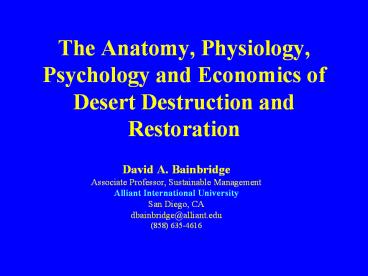The Anatomy, Physiology, Psychology and Economics of Desert Destruction and Restoration - PowerPoint PPT Presentation
1 / 27
Title:
The Anatomy, Physiology, Psychology and Economics of Desert Destruction and Restoration
Description:
The Anatomy, Physiology, Psychology and Economics of Desert Destruction and Restoration ... The desert remains under unprecedented assault from development, ... – PowerPoint PPT presentation
Number of Views:73
Avg rating:3.0/5.0
Title: The Anatomy, Physiology, Psychology and Economics of Desert Destruction and Restoration
1
The Anatomy, Physiology, Psychology and Economics
of Desert Destruction and Restoration
- David A. BainbridgeAssociate Professor,
Sustainable ManagementAlliant International
UniversitySan Diego, CA dbainbridge_at_alliant.edu
(858) 635-4616
2
Play time!
3
Introduction
- Desert degradation is usually caused by a set of
interlocking factors - These include the fragility of the desert
environment, flawed economics, weak laws and
regulations, and human "needs" for immediate
gratification - A doctor can't cure many diseases without
treating the causes, neither can we
4
Anatomy
- The desert remains under unprecedented assault
from development, infrastructure, air pollution,
nitrogen deposition, invasive species, military
operations, mining, and OHV activity - OHV activity is the least necessary, very
extensive and very damaging - The full extent of OHV damage remains unknown
5
Hill climb damage
6
Physiology
- Plant communities are disrupted by direct
impacts, crushing, and damage to roots - Weed invasions are may make desert ecosystems
much more vulnerable to fire - Compaction is often severe in heavily used areas
and infiltration can be very limited - Water flow changes and erosion increases
- Reduced levels of hyphae and bacteria are found
7
Change in water flow
8
Damage is extensive
- The most apparent level of OHV damage is total
destruction of all vegetation in high use areas - Even in areas of moderate use the damage is quite
extensive, although to the untrained eye it may
appear less severe if the larger shrubs are still
standing - Extensive use of desert washes for OHVs has been
a disaster for wash ecosystems
9
Dove Springs
Fence line
10
Psychology
- Understanding the allure of OHV operation is not
difficult its fun - OHV exploration (the more sedate part of the
population) enables families to discover new
areas and enjoy the beauty of the desert - It makes it easy to reach remote areas for camping
11
OHV play areas
- OHV play is noisy, involves speed and power,
danger, and requires intense concentration - A small percentage of the OHV population needs
the added "kick" of outlaw behavior - Flouting route restrictions, damage of
undisturbed areas, vandalizing gates, signs, and
displays, smashing plants
12
Hill climbs
Extremely difficult and costly to repair
13
Failed education
- The OHV community, like most Americans, have
"affluenza", falling prey to relentless and
sophisticated advertising, "If I just have more,
I'll be happy" - Poorly educated by a failed school system, they
also have no concept of Nature's Services",
Natural Capital", and "sustainability"
14
Economics Its the economy, stupid
- The OHV community of manufacturers, retailers,
and suppliers and their advertising agencies and
dependents is big business. - The economic impact is 5-10 billion dollars a
year in California. - More than 40 of the money spent on OHVs is for
vehicles and almost 10 is for fuel.
15
Flawed accounting
- Existing economic analyses neglect environmental
affects and uncompensated costs to taxpayers - This provides a picture of OHV economics that is
so misleading it would make Enron's accountants
blush.
econ activity minus damage eco less than zero
Mojave
Japan
Detroit
16
Autistic accounting
- Neoclassical economics says value is determined
by sales price or use value, perhaps 500 to 700
per hectare - Ecological economics says a better way to judge
value is replacement cost, perhaps 50,000 per
hectare - Knowing this we can say that a full size 4x4 can
do 40,000 dollars of damage in a day of ripping
across the virgin desert
17
Restoration experience has illustrated the high
repair costs
Tall pots for revegetation At the Ant Hill Anza
Borrego
18
Dove Springs
- Damage and repair assessment
- Condition Area/length Cost/unit Total ha
denuded - or dense tracks 194 50,000 9700000with
OHV impact 740 20,000 14800000km
route 576 12,000 6912000km wash
routes 77 25,000 1925000 Net
33337000 Damage assessment from Matchett
et al., 2004. Repair estimates from experience.
19
Other uncompensated costs
- Some could be determined, but haven't been well
studied while others are quite challenging to
cost - Medical treatment, perhaps 20-30 million a year
- Enforcement
- Cleanup and repair of facilities and fixing
vandalism - The economic cost of Global Change
- The economic cost of weed control
- The economic cost of increased fire risk
20
Cost related to Natural Capital and Nature's
Services
- What is the value of biodiversity? Of beauty?
- Of endangered species? Of natural hydrologic
function? What is the ecological cost of exotic
species invasion? - What is the ecological cost of increased fire?
- The ecological cost of nitrogen deposition?
- What is the ecological cost of global warming?
- Almost certainly these are in the billions...
21
Subsidies
- Subsidies - you gotta love em!
- Analysis of automobile operation in the U.S.
suggests we all get about a 90 subsidy - OHV operators are currently getting a subsidy
closer to 99, but users complain heavily about
existing fees - An OHV green sticker costs only 12.50 a year,
just 50 a year for an OHV park pass, or 90 a
year for an Imperial Dunes pass - In contrast 120 a year for a state park pass!
22
OHV industry profits, taxpayers pay
- The OHV industry is mining the value of the
desert at the expense of the desert owners (the
American public) and future generations - The value of the desert's scenic beauty, Natural
Capital", and Nature's Services" is being
exported to Japan and Detroit - While the beneficiaries pay lip service to "tread
lightly", advertising almost always shows the
"tread heavily" mode
23
The future
- Desert destruction and restoration is not
primarily a technical problem - The root cause of desert destruction is
ultimately poor accounting - It will be difficult to do anything about the
enormous problem of desert deterioration until
we address these drivers - Until we do, we are as the Dutch say, "mopping up
the floor without turning off the water
24
The education problem
- Users need to be aware of costs, impacts, and
responsibility - Control of the outlaws is most important,
responsible off-highway recreation is less of a
problem - I like OHV activity but dont ramble off route,
just as I would like to shoot skeet in the
Crystal Palace but dont
25
Just because its fun, doesnt mean its right
Skeet shooting in the Crystal Palace would be fun!
26
Manufacturers should play a bigger role in tread
lightly
- A special sales tax on OHVs (5- 10) might be
desirable - OHV manufacturers should be charged 50-100,000
for each advertisement exhibiting "tread heavily"
behavior - If a park pass costs 120 a year, then an OHV
pass should probably cost 1,000 a year - If a ski pass costs 36 a day, then an OHV pass
should be probably cost 100 a day - Implementing this level of fee would be
politically unfeasible, but perhaps 250 a year
would be plausible
27
Taxes and fees would help pay uncompensated costs
- Medical system costs
- Better management, enforcement
- Critically needed funding for research (Recovery
and Vulnerability 50 million year) - Active restoration program (50 million year)
- Money to develop new, high quality OHV play areas
on lands removed from agriculture due to water
transfers - Funding for new OHV play areas closer to urban
areas































